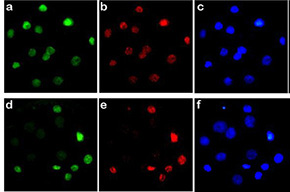

Study recently published in the online edition of Nature included significant input by Brazilians (image: Clara Slade Oliveira)
Study recently published in the online edition of Nature included significant input by Brazilians.
Study recently published in the online edition of Nature included significant input by Brazilians.

Study recently published in the online edition of Nature included significant input by Brazilians (image: Clara Slade Oliveira)
By José Tadeu Arantes
Agência FAPESP – Despite the remarkable scientific advances that have been made in recent decades, one of biology’s greatest questions continues to intrigue researchers: how does the process of cell differentiation occur – what makes the zygote, a cell capable of generating any tissue in the body or placenta, give rise to the specialized cells that make up individuals?
In this process, the first lineage specification occurs even before implantation of the embryo and culminates with the formation of two cell lineages: the inner cell mass, with the pluripotent cells that will give rise to all embryonic tissues, and the trophectoderm that will form the embryonic portion of the placenta but will have no further role in the formation of the adult. It is still not completely clear how this first differentiation occurs or what factors determine which cells will differentiate and which will remain pluripotent.
A recent study that brought together teams from a number of countries has added another piece to the puzzle. The study, titled Citrullination regulates pluripotency and histone H1 binding to chromatin, was published January 26 in the online edition of the journal Nature.
The multidisciplinary team, which included such names as John Gurdon, winner of the 2012 Nobel Prize in medicine, also included a Brazilian who played a prominent role: Clara Slade Oliveira, doctor of veterinary medicine from the Universidade Estadual Paulista (Unesp) and FAPESP funding recipient, is currently a researcher with the Brazilian Agricultural Research Corporation (Embrapa) at its Santa Mônica Experimental Field Animal Reproduction Laboratory in Valença, Rio de Janeiro.
“The study whose findings were published in the Nature article dealt with the activation of certain enzymes that modify histones [the main proteins that make up the cell nucleus] in the initial phase of embryonic development, that is, before implantation of the embryo in the mother’s uterus. During this period, the zygote, which is the structure formed through fertilization of the ovum by a sperm cell, develops into a blastocyst, initially a structure that has fewer than 100 cells and is characterized by the presence of two distinct cell lineages,” Oliveira told.
The main enzyme in question, peptidylarginine deiminase 4 (PADI4), appears to play an essential role in regulating the process of cell differentiation. “During the initial stages of embryonic development, cells can give rise to any tissue in the body and placenta. Once the blastocyst forms, there is a clear separation into two groups of cells: the inner cell mass (pluripotent) that gives rise to the embryo and the trophectoderm that forms the embryonic placenta. After this differentiation, the trophectoderm cells no longer take part in forming adult tissues. PADI4 contributes to the formation of the pluripotent compartment,” Oliveira explained.
She observed this enzymatic activity during her doctoral work conducted on the Unesp campus in Jaboticabal (SP) under the guidance of Professor Joaquim Mansano Garcia. She conducted a more specific study regarding the role of PADI4 during her post-doc research at the University of Cambridge with Professor Magdalena Zernicka-Goetz, one of the co-authors of the Nature article.
“We worked with two inhibitors of this enzyme: Cl-amidine and Threonine-aspartate-F-amidine (TDFA). We analyzed these inhibitors, selected the best concentration for inhibition and used that concentration to cultivate mouse embryos in this medium. We then fixed the embryos in the blastocyte stage and conducted immunocytochemical analyses to determine how many cells from each lineage (those that were still pluripotent and those already specialized from the placenta and primitive endoderm) were present in the samples,” said Oliveira in reporting the details of the study.
When the embryos were cultivated in the medium composed of enzyme inhibitors, the researcher observed more cell differentiation compared with the embryonic pluripotent cells, which confirmed the role peptidylarginine deiminase 4 plays in forming the pluripotent cell stock.
“There are other drugs that activate the PADI4 enzyme instead of inhibiting it; but they are still being tested. When these activators are available, we will cultivate embryos in a medium supplemented by them and will thus be able to have a larger pluripotent compartment that can eventually be used to produce embryonic stem cells, for example,” Oliveira said.
Even now, however, the applicability of the research seems quite likely when considering the heterogeneity of the groups involved. The study is led by professor Tony Kouzarides’ group at the University of Cambridge, which works with epigenetics and cancer. A possible duplication of the study could result in obtaining new resources to inhibit the proliferation of tumor cells.
The article Citrullination regulates pluripotency and histone H1 binding to chromatin (doi:10.1038/nature12942) is available to subscribers of Nature online at www.nature.com/nature/journal/vaop/ncurrent/full/nature12942.html.
Republish
The Agency FAPESP licenses news via Creative Commons (CC-BY-NC-ND) so that they can be republished free of charge and in a simple way by other digital or printed vehicles. Agência FAPESP must be credited as the source of the content being republished and the name of the reporter (if any) must be attributed. Using the HMTL button below allows compliance with these rules, detailed in Digital Republishing Policy FAPESP.





